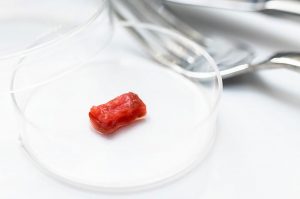Ours is an industry that attempts to marry advanced biotechnology and machinery with salt-of-the-earth values and perceptions. Because of that, one of the questions that frequently comes up in the agriculture industry is, how do we integrate modern food products with traditional ones? It’s such a vital and timely topic that Farm Bureau’s Young Farmers & Ranchers have even addressed during their annual contest titled, Discussion Meet.
Specifically, members are being asked: “Products like cell-based food products have demonstrated the food system is rapidly changing. How can future food technologies and related products be beneficially integrated into modern agricultural production without hampering the success of traditional products and the farmers and ranchers who grow them?”
I am involved in the beef industry and am a die-hard beef burger connoisseur, so I know why many of these new food technologies aren’t welcomed in the industry. And as is often the case with production and sustainability, there isn’t a simple black-and-white answer to solve the issue. However, there are many modern food products coming into the industry, including plant-based meats, that we need to be aware of. Younger (and often urban) generations are driving the change, and these products aren’t going away anytime soon. Like tofu, this will be another option for consumers to choose, and we all have to remember: This is their right. This doesn’t mean, though, that consumers understand how modern foods can affect the reliability of the food supply they have now. There are high expectations for modern agriculture to meet in order for any consumer to trust and any traditional farmer and rancher to consider supporting, but that doesn’t mean we all shouldn’t try to work together to make sure the world has the safest and cheapest supply of food possible.

And this idea goes well beyond innovations such as a cell-based foods.
It’s no secret that the number of people directly involved in production agriculture is dwindling rapidly. The American Farm Bureau reports that less than 2 percent of the population work directly in farming and ranching. Additionally, amid fluctuations in regulation and policy, the workforce is drastically changing as well. For these reasons, agriculture has to evolve, as it always has, in order to become more efficient and provide more food to more people using less resources. Accomplishing that is a strain many farmers feel on a daily basis.
Related article: A letter to animal ag: Back off of fake meat and milk, by Kevin Folta
Farmers are able and willing to provide jobs for migrant workers and essentially anyone who is willing to put in the hard work. However, it’s often hard to find manual labor, and this is hurting the industry, pushing it towards mechanization. Young people in rural areas are becoming more educated and often seeking better or higher-paying jobs rather than working in fields or on ranches, yet another driver towards technological advancement. Modern food production means more careers in the industry that are fit for college graduates. Workers, especially in places such as California, are able to fight for higher wages, shorter working hours, and other benefits, which is costly to agricultural producers — with modern production methods, there isn’t as much demand, or struggle, to find workers.
However, allowing modern products and technology to exist, like cell-grown foods, can be frightening to think about. This is completely understandable, and having a level of cynicism is healthy. There is still a lot of research to be done to determine all of the effects on health and the environment, and I fully believe in regulating this product as well as having proper labeling — we need even more transparency and honesty in our labeling rather than marketing ploys. Products, like cell-cultured meat, need to be labeled as such rather than being called “clean meat,” to prevent deceiving consumers and wrongly stigmatizing livestock producers.
Another huge consideration for integrating modern foods into the industry is international health protocols. Even though the United States has the safest food supply, we face some food safety risks, such as romaine lettuce in 2018 or Bovine Spongiform Encephalitis (mad cow disease) in the early 2000s. Traditional agriculture has many protocols in place to protect consumers and the industry during crises, and we are able to manage and be better prepared for these scenarios from the many years of improving safety regulations, to educate food industry workers on how to handle food, and to maintain strict biosecurity on farms. Modern food producers will need to prove that they can handle health hazards and have procedures in order to prevent and contain any major dangers to consumers.
Modern food doesn’t only affect the United States; other countries must be considered in this technology. According to an article by Harvard Business Review, “Food demand is expected to increase anywhere between 59% to 98% by 2050.” The population is also set to increase over 9 billion by the year 2050, so more food will need to be produced (and current production will need to be better utilized ) to meet the needs of people. If we are growing food in labs, or becoming more efficient with our own food sources, what happens to our relationship with those we import from and export to? Will they accept our new technologies? Will we need their food source anymore? It is important for a country to be able to rely on its own food source, but with the countries we have spent many years building economical relationships with, such as Canada and Mexico, how could this impact those? New food technologies will allow us to feed many more people, but we have to be cognizant of what the global demand is asking.
This article could go on and on regarding the complicated relationship between modern and traditional food products, but I will end with the byproducts of plants and animals. If we are creating modern food technologies, especially if they are from a lab, what happens to the endless list of byproducts we get today from animals and plants? Medical supplies, pet food, milk, everyday personal and house supplies, etc. — many of these are created using our current agricultural supplies. The need for animal byproducts, especially, is still high, so what will happen to the supply of these if we go toward modern food products that are synthetic in nature?
We live in a country where our food supply allows us to have the demands for modern foods. We are able to choose what we want to eat based solely on value and emotions, but not all countries have this luxury, and many people in our own country still struggle to feed themselves. Modern food products have the power to end mass starvation, and the ability to improve an already great industry, but we have to be careful what we wish for. Farmers and ranchers are sacrificing many things in order to create better plants and animals, better environmental impact, and better lives for the world; we can’t “bite the hands that feed us,” by turning to synthetic products, or technologies that will cause them to suffer more. These modern food products will have to meet many more demands and answer many more questions than I have listed above, before they can find harmony, if possible, in our food supply.
Markie Hageman majored in agribusiness at Fort Hays State University. She is actively involved in her state Cattlemen’s Association, Young Farmers chapter, and National Cattlemen’s Beef Association. Her AGDAILY.com articles can be found here.



